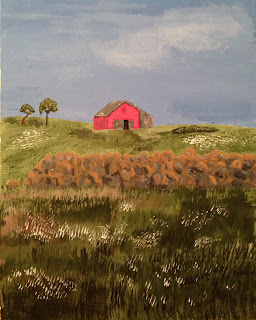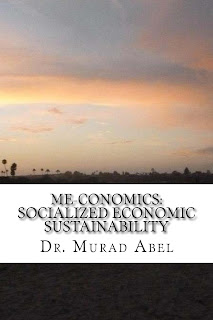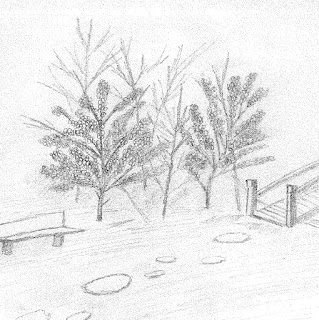
The blog discusses current affairs and development of national economic and social health through unique idea generation. Consider the blog a type of thought experiment where ideas are generated to be pondered but should never be considered definitive as a final conclusion. It is just a pathway to understanding and one may equally reject as accept ideas as theoretical dribble. New perspectives, new opportunities, for a new generation. “The price of freedom is eternal vigilance.”—Thomas Jefferson
Showing posts with label murad abel. Show all posts
Showing posts with label murad abel. Show all posts
Monday, February 10, 2014
Friday, June 14, 2013
Creating Lasting Change Using Organizational Strategy
A successful organizational strategy requires the
fundamental changing of behavioral patterns and economic structure to meet
environmental needs. Executives have developed the ability to adjust policies
& procedures, communicate their needs, and implement strategic approaches
but often fail to understand the cultural significance of employee thought
patterns in achieving their results. It is the agreement of employees and their
ability to understand the economic rules of their organizations that will
determine how successful the company will become.
By understanding what motivates employees to perform,
encourage proper behavior through satisfaction, and helps them find solutions
to problems through innovation an organization create a more efficient system
that can compete effectively in the market. Each organization is a
socio-economic hub that maintains cultural vantage points that will determine
either its success or its failure through specific employee behaviors.
For example, let us assume that an executive has designed a great strategy and tries to implement that strategy but ignores the complex
human behavior that will lead to the proper adoption of that strategy. The fruitation
of strategy will be determined by employee’s ability to understand the strategy
and change their work patterns to fulfill the particular goals of the
organization. When they either do not understand the strategy or feel that it
is not beneficial to their goals they will create resistance and inefficiency.
This inefficiency can be seen in absenteeism rates, wasting of
resources, resisting management decisions, poor workmanship, turnover rates and
passivity to the environment. The end result is that the organization fails to
meet the outlined objectives and continues to experience lackluster
performance. Engaging in chest pounding, discipline, hair pulling and strong
arming to turn around the situation will only create additional resistance and
lower the engagement of workers making such executive approaches
counterproductive.
The ability of encouraging, engaging, and coaxing employees
to higher levels performance and development is a constant necessity within organizations.
The particular networks and socialization aspects of the organization are
determined by the norms, values and communication strategies that organizations
adopt. Understanding the social aspects of the company will allow for the
development of stronger norms and values that are self-enforcing and
encouraging of innovation and adaptation.
Any development of strong strategy must consider both the
economic and the human elements to be successful. The book Me-conomics: Socialized
Economic Sustainability will bring readers through cultural background of
capitalism, the way in which employees make meaning of their work environment,
the development of efficient thought patterns, and the economic advantages of
furthering employee satisfaction, motivation and innovation. Decision-makers will
find benefits in furthering their understanding of strategy and its human
elements to find success for both themselves and the employees they coach.
Thursday, June 13, 2013
Short Story: Dusk to Dusk, Ashes to Ashes
 |
| Painting by Dr. Murad Abel |
Short stories have the ability to spark the imagination and
lead the reader with a thought or concept to ponder. Each store is unique and
became popular over the 17th and 18th centuries from the
storytelling of the past. They made their way into magazines, books,
newspapers and other printed works. The short story is designed to quickly
entertain the reader while leaving a lasting impression.
Short short stories, or flash fiction, has a basic structure
such as the exposition (introduction), complication, climax and resolution. The
difficulty with such stories is that they are so short it is hard to build a
story with dynamic characters and therefore descriptions are generally brief
and artistic. It isn’t easy to write a clear store within a page or two.
Short stories are also known in China where they are called “smoke
long” which means they are finished in about the time you smoke a cigarette. Most
of the great writers like Ernest Hemingway and Edgar Allen Poe wrote a few
short stories. Some writers collected all of their short stories and put them into a book.
Title: Dusk to Dusk, Ashes to Ashes
The little barn on the hill has been barren for over a
generation with no one to claim it as home. Weeds have grown where bountiful
crops once stood, the paint is peeling, the door has long been broken by local thieves,
and the two-rut road has blended into a dandelion's paradise. Its neatness long transformed into the chaotic
order of nature. Horses, pigs, and cows were sold lifetimes ago after old man
Granger said his famous words, “dusk
to dusk, ashes to ashes, it is time for me to close my lashes.”
Nature moved in and claimed the grounds slowly by coaxing it
back to the place from which it came. Little trees have risen in the once plowed
fields while the fences have crumbled into ruble. It rested abandoned until little
Samuel, from just up the rocky road, claimed the old barn as a fort for his adventures,
hideouts, and as a haven from the day’s events. The walls may be lined with the
droppings of birds, the ceiling full off abandoned bee hives, and the dirt floor
sprinkled with the footprints of country critters but it contained within its
dampness the treasures of another life.
Manual mowers, pots, tools, hammers, rusty nails, birthing
calipers and a host of other abandoned tools were thrown about the place in random
fashion. With his flat black hair, corduroy trousers, and dusty boots old
Granger’s barn became a place of refuge from the troubles of childhood life. Once known it didn’t take long before a clan of fellow kinsman also adopted
the place for their personal refuge. One by one they came to explore. To the fourth grade countryside class
it was a location of freedom from parental oversight, a place where things could
be stowed away, a social place for young boys who deemed it their secret
hideout and launching pad for wild adventures.
As little Samuel grew
and so did his partners and the old barn took on new purposes and uses.
Football, dodge ball, BB gun fights, throwing stars, beer, firecrackers, and
all the other rowdy activities young teens engage in, were common
weekend occurrences on old Granger’s land. To Samuel it was the place he first
shot a deer, just down the gravel road from where he once pulled 50 suckers
from the stream within an hour, and about a mile from where he and a friend
smashed mail boxes in a game of “roadside baseball”. The center of the earth existed within ten miles of nowhere.
It still maintained its charm in high school where a long
line of barely operable cars and trucks made their way up the two rut umbrella
of trees and into the open field. Bonfires, benches, and brews kept the
stories flowing that would spook even the most hard hearted of listeners. Many nights were
spent looking up at the dark open sky talking about all the things that young
adults talk about. Girls, money, baseball, politics...no topic was taboo. The dribble drivel of dreams. The stars were always on display as no light but the glow of an open fire was standing
between man and his universe.
Despite its years of childhood abuse that farm building
couldn’t withstand the power of an angry spirit. A twister moved through and tore
the roof clear off and threw it somewhere in the field. The walls crushed inward
covering its history and ending its era. Samuel walked around the pile of ruble
kicking the debris thinking of all the fun he had in this decrepit place. Bending
down to tie his shoe he noticed a coffee can with the cover half torn off. Lying
in the grass was a $20 bill, letters, and a few black and white pictures. He
reached down, blew the dust off, and began to read one of the aged pages. “Dearest Janet, it is these gassed trenches….”
For days Samuel did nothing but read and reread the letters,
peer into the pictures, and try and decipher the life history of old man Granger. The
more he asked people about this idealized character the more he learned that all that knew
him were also long gone. From the letters he could determine that old man Granger was in trenches in
WWI and was in love with a Janet from Wisconsin. They wrote to each other on a
regular basis and married afterward. When finished, each letter was folded with meticulous care and placed in the coffee can along with pictures of old man Granger
and his beloved Janet. The $20 bill was an odd temptation and more
than once the 18 year old Samuel thought about spending it on something important. Movies, gas, clothing...the needs were endless. At each moment he lifted it out of the can, he dropped it back in thinking
it might bring him good luck if he holds onto it a little longer.
Nearly 60 years have passed since Samuel has visited the old
farm property. After taking care of financial affairs, hosting family visitors,
and listening to the blessings of priests he desired to pay homage to the earth one more
time. All the documents have been signed, his children are taken care of, his
grand children have their financial futures secured, and his wife’s grave was decorated
with newly cut flowers. With his grey shaking hands he mustered all his
strength and dropped a few new sheets of papers, pictures, and a fresh $20 bill, bundled with the old,
into the can and slide them next to the tattered yellow papers of old man
Granger. With a motion of his finger he tells the nurse to give the fresh and smartly
dressed attorney standing in the hallway his package with clearly written instructions. Let the young man know, “dusk to dusk, ashes to ashes, it is time for
me to close my lashes.”
Dr. Murad Abel
Thursday, June 6, 2013
The Meaning of A Boundless Moment by Robert Frost
A Boundless Moment by Robert Frost
He halted in the wind,
and — what was that
Far in the maples, pale, but not a ghost?
He stood there bringing March against his thought, And yet too ready to believe the most.
"Oh, that's the Paradise-in-bloom," I said;
And truly it was fair enough for flowers
had we but in us to assume in march
Such white luxuriance of May for ours.
We stood a moment so in a strange world,
Myself as one his own pretense deceives;
And then I said the truth (and we moved on).
A young beech clinging to its last year's leaves.
Far in the maples, pale, but not a ghost?
He stood there bringing March against his thought, And yet too ready to believe the most.
"Oh, that's the Paradise-in-bloom," I said;
And truly it was fair enough for flowers
had we but in us to assume in march
Such white luxuriance of May for ours.
We stood a moment so in a strange world,
Myself as one his own pretense deceives;
And then I said the truth (and we moved on).
A young beech clinging to its last year's leaves.
The poem is one of seasons changing and the cycle of life.
Each May the bloom comes out and brings life to the death of winter. The poem
is about a single moment when the characters see that life has changed. The
layers of meaning can be deep but on the surface it appears Robert Frost is
discussing nature and its cyclical momentum. Everything in nature moves through patterns.
The poem indicates that he is walking with someone. The
pastoral beauty of nature has caught their eye and they pause for just a
moment. They gaze into nature and its ever changing existence-a paradise of
bloom. The author discusses a piece of truth to his companion and both move
on. He feels as though he is in a strange world where pretenses fail our human
understanding of our place within it all.
In the last sentence we see a comment about a young beech
clinging to its last year’s leaves. It is possible to see this as how we always
cling to what was before and fail to embrace the new. No matter how much we
cling to the past change sweeps up us all. We can’t live in the past. The tree
with a single leaf could be a metaphor for how we try and maintain our youth
and past, but life will make it all fall away. Humans and nature are part of the
very same existence.
Tuesday, June 4, 2013
The Fog Warning by Winslow Homer
 |
| The Fog Warning (1885) |
In Winslow Homer’s painting The Fog Warning (1885) he paints
a halibut fisherman that is racing against the clock of time. As you can tell
from the painting he has a large catch for such a small boat. Perhaps he stayed
out just a touch too long in his effort to maintain his livelihood. To small
fishing boats a few large fish can make a huge difference in the lifestyle they
gain. There is a temptation to test the powers of nature in achieving one’s
goals. It is a picture that pushes one to see the how connected man is to
nature.
We can see that there is danger in the painting. The man is
on the sea, the winds are pushing him hard, the waves could capsize his
weighted ship. We can envision that the clouds are coming and a storm is
brewing. The man may have ignored the fog warning and decided to fish just a
little longer than was necessary. The goal of the painting is to stimulate nervousness
with the fisherman being alone fighting against the elements.
The fisherman is looking out over his shoulder trying to
judge whether or not he will make it to shore. There is no shore in site but
off in the distance is a ship. Hope! The clouds are coming and his boat is
bouncing. The dark colors and clothing of the painting show it is cold outside.
It is a painting of fear, loneliness, danger, and judgment. Its appeal is in
how the emotions are elicited in the viewer.
Winslow Homer was an American Painter who was well known for
his nautical and landscape paintings (1836-1910). He was a highly influential
painter in the 19th Century who started as a commercial illustrator
and then moved into oil painting. He was self taught and developed a skill
unique to him. He worked with both oil but also water colors which allowed for
a slightly different style in his productions.
Homer was born in Boston Massachusetts and took the skill of
his mother to another level. His father was a businessman who went through a
number of businesses, the gold rush and finally went to Europe to seek capital.
He left his family in search of greater glory. Upon Homer’s graduation his
father set him up in an apprenticeship that marks the beginning of Homer’s amazing
career.
In his work as an illustrator he contributed to important
magazines such as Boston Life and Harper’s Weekly. He studied one year at the
National Academy of Design and was sent to the Civil War to draw paintings. After
this time he worked on drawing paintings of simpler times for himself and the
nation. He drew family, children, livelihoods, and young women. His work was so
loved it made its way into a 1962 stamp.
Perhaps we should never ignore the fog warning!
Thursday, March 28, 2013
Creating Customer Loyalty through Technology Implementation
We are now in the service economy
and should learn better on how to integrate technology within the e-commerce
world. Considering the explosion in online marketing and service management it
is possible to understand the growth in online service research. Understanding how
customers view the value of such services is important for overall improvement.
Service quality is important for
customers who desire to perceive the value of their purchases worth more than
the effort and cost of buying the product. When this perception of service
quality is high such customers will often reward organizations with higher
levels of loyalty. Research has supported the concept that customer loyalties
are based in this service quality (Gefen, 2002).
New technologies have created the
age of e-commerce. This technology has developed fundamental differences in the
way people interact and conduct business with customers. More importantly, it
also changes the way in which individuals perceive customer value, how they
obtain information, and the very nature of economic exchange.
Customers are not only making
investments in the product but also the company. When a customer spends their
time and resources trying to obtain a product or service they are causing
customer sacrifice (Brandy et. al., 2005). It is this sacrifice that makes its
way into the subjective evaluation of comparative worth.
Through social exchange theory people
can better understand the process of comparative exchanges that both companies
and customers make. Understanding the online goal directed behavior and exchange
of time and effort toward products helps to understand how to provide such services
(Zeithaml, et al. 2002). Doing so will better help organizations align their
services to the customer’s needs thereby adjusting the perception of this
exchange into a more positive one.
A study conducted by Xu,
Benbasat, and Cenfetelli (2011) analyzed service quality, sacrifice, service
outcome, and customer loyalty related to products. Participants helped a friend
shop for a laptop based upon a number of defined criteria. A total of 128 subjects with various
backgrounds were used within the study to provide diversity of perspective. The
researchers desired to define the relationship between online service and
purchases of products.
Results:
-Service quality and customer sacrifice influenced
perceived service outcome.
-The effectiveness of service dimensions
is influenced by the customers’ product knowledge.
-Support for Social Exchange Theory
indicates that if customers feel that their service quality and service
outcomes were beneficial they will reciprocate with future purchases and
loyalty.
-Customer sacrifice (time and effort) is
relative to the quality of the product.
-Customers with high product knowledge
are influenced by lower customer sacrifice versus service quality.
-Websites with live help reduces the
perceive customer sacrifice factor and raises perceptions of positive quality
experience.
Analysis:
As e-commerce grows as a preferred
method of conducting business it is important for organizations to improve
their overall understandings associated with customer relationships. Creating
higher levels of virtual platforms that foster, versus hinder, customer search
preferences can lead to increased sales. In addition, limiting the amount of
customer sacrifice required by offering quick methods of communicating with
representatives can also raise overall satisfaction levels. It is through weighing and balancing the use
of modern technologies that can we create higher levels of positive customer
perception and loyalty.
Author: Dr. Murad Abel
Brady, M., Knight, G.,
Cronin, J. , Tomas, G., Hult, M., & Keillor, B. (2005). Removing the contextual lens: a multinational,
multi-setting comparison of service evaluation models,
Journal of Retailing, 81(3), 215–230.
Gefen, D. (2002). Customer
loyalty in e-commerce. Journal of the Association for Information
Systems, 3(1), 27–51.
Zeithaml, V. A., Parasuraman, A.,
& Malhotra, A. (2002). Service quality delivery through web sites: acritical review of extant
knowledge. Journal of the Academy of Marketing Science, 30(4),
362–375.
Xu, J., Benbasat, I., & Cenfentelli,
R. (2011). The effects of service and customer product knowledge on online
customer loyalty. Journal of the
Association of the Information Systems, 12 (11).
Subscribe to:
Posts (Atom)

